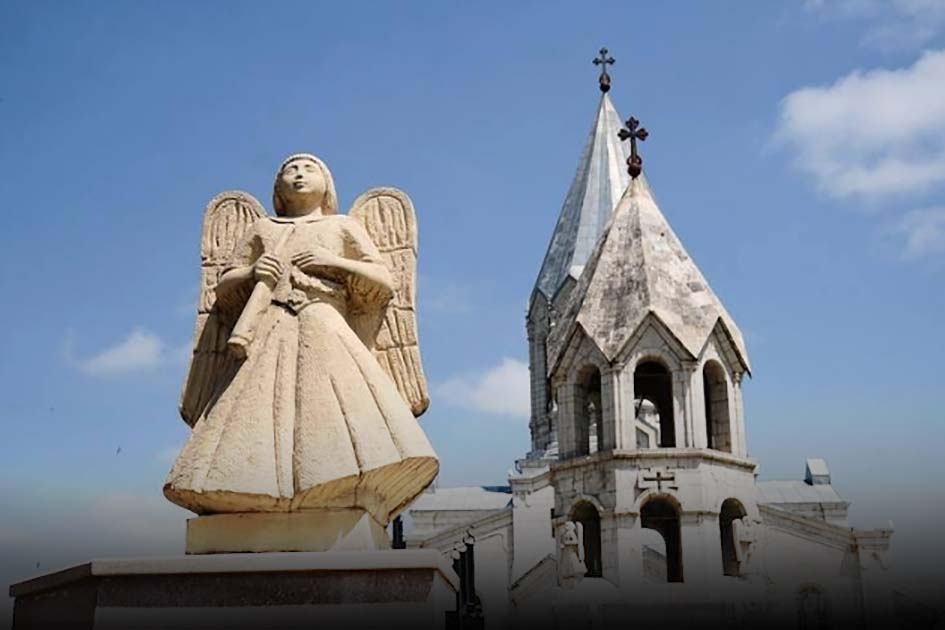
Every Sunday during the Armenian Apostolic Church’s Divine Liturgy, the priest exhorts the worshipping faithful to sing together with the angels, to “boldly cry out” with the “seraphim and the cherubim.” The song from the Badarak, the Divine Liturgy, is known as the Sanctus, meaning “Holy,” in Armenian Surp. It is found in almost all the ancient liturgies—the source of the text is from the Old Testament book of Isaiah, itself repeated in the Book of Revelation. The song, often known in Armenian as Surp, Surp (which you can hear here), is the song that the Bible says the angels in Heaven sing continuously in praise of God. By asking us to sing together with the angels, the priest offers angelic hosts to us as an example, a source, of prayer and worship. The song also demonstrates how the Bible itself is the source of much of Armenian worship. Today, we will discuss this most unlikely of sources: angels!
Angels, while a ubiquitous aspect of Christianity, are perhaps surprising as a source in the sense usually meant in this column. To begin with, angels are rather mysterious: we portray them with wings and white robes, often with halos just like the saints. While there are many Biblical appearances of angels, there are only a few direct descriptions of angels in the Bible, and, as Arpi Nakashian points out in an article for Vemkar, much of our angelic imagery is the stuff of Halloween costumes. The seraphim, a type of angel, are described by Isaiah, and the cherubim are named as another group of angels, but the Bible only ever offers names to two individual angels: the Archangels Gabriel and Michael. It is these two angels whom the Armenian Apostolic Church commemorates on Saturday, an unusual twist on the celebration of saints on Mondays, Tuesdays, Thursday, and Saturdays.
As Patriarch Shnork Kaloustian wrote, “the Church venerates not only saints but also the angels.” In other words, on a day normally reserved for the commemoration of human saints (Saturday), this week, the Armenian Church venerates the Holy Archangels Gabriel and Michael. This means that like human saints, we see in the angels a source of spiritual inspiration, an icon of the Divine, an example to follow. While only these two angels are mentioned by name in the Biblical texts accepted by all Christians, other angels are named in the books commonly called the Apocrypha, also known as the Deuterocanonical books. For instance, the archangel Raphael is mentioned by name in the Book of Tobit. Other texts, from both Jewish and Christian writings, name individual angels, and some of these angels have made their way into Christian artistic and textual sources. One of the most famous writers to name other angels, and to offer a description of angels in general, is the famed Medieval Jewish thinker Maimonides. In the Christian theological writings, the most important description of the angels comes from an author we discussed in a previous column, Pseudo-Dionysius the Areopagite. His Celestial Hierarchy, describing nine different types of angels, is the standard Christian account of angels.
Angel means simply “messenger.” In addition to being examples of praise and prayer, in the Bible angels are those who transmit God’s message—the words of God—to humanity. Most famously, the Archangel Gabriel announced to the Virgin Mary that she would bear Jesus Christ, the very Son of God. Known as the Annunciation, and celebrated by the Church every year, at that moment Gabriel spoke for God. The Annunciation inaugurates the Gospel story, as it is the very proclamation of the imminent arrival of Jesus Christ, whom St. John the Evangelist calls the Word of God. God’s words, his promise to Mary, are brought by the messenger Gabriel to prepare for the arrival of the Word of God into the world. While angels do many things in the Bible, such as dine with Abraham, praise God, and inspire prophets, we see here, in the words that announce the Incarnation of the Word of God, the incarnational logic at the heart of the meaning of the angel as messenger.
The Incarnation is the heart of Christian teaching, the idea that God became human, flesh and blood, in the person of Jesus Christ, in order to be sacrificed for humanity’s sins and ultimate salvation. Never separate from the Crucifixion and Resurrection in Armenian theological thinking, the Incarnation is the first step in what is called the economy of salvation. While all of the Gospels highlight Christ as God-become-human, it is John the Evangelist who offers a sophisticated theological account of the Incarnation. In the Gospel of John, Jesus Christ is called the “Word of God,” using a Greek word Logos. The idea of the Logos is full of philosophical baggage. It is a term used by Plato, by the Alexandrian Jewish interpreter of Scripture Philo, and later by neo-Platonic philosophers who would influence Christian thinking. Logos can mean “word,” but it carries other connotations, including the Divine Plan for the world or a kind of rational principle. We will return later to Christian and Armenian Christian reflections on the idea of the Logos, in Armenian rendered as pan/ban. Today, we emphasize that in the Gospel of John, the Incarnation, the coming of God into the world as a human being, is making present and material the Word of God, the Divine Logos. If that is true, then the work of the angels as messengers is also a kind of incarnation, a making present the word of God. Indeed, if, as Arpi Nakashian writes in her discussion of angels, “Christ Himself is the Message” that an angel as a messenger brings, then the incarnational aspect becomes even more explicit: angels make present not only the words of God, but the Word of God.
The Incarnation understood as the indwelling of the Logos in the world as Jesus Christ is the source of Christian salvation. Reflection on Logos as both the person of Jesus Christ and as a complicated philosophical principle is the source, the spring from which so much Christian theology flows. Indeed, if Logos encompasses language and rationality, then Logos, the Word of God, Jesus Christ, is not only the source, but the very possibility of theology. Angels, as the messengers who present God’s words and announce The Word, can then themselves be understood as sources for Christian living and theology.

